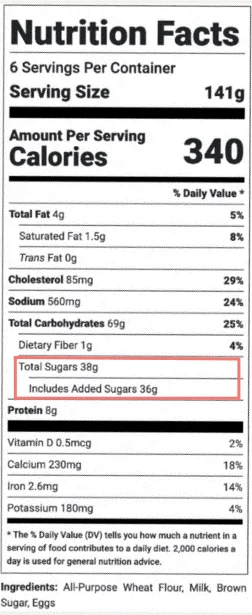Sugar has been a controversial topic for healthcare professionals, fitness influencers and even the general public over the last few years. Society has moved more towards being health-conscious and stringent in terms of what they are choosing to eat and consume in their everyday diets. Sugar has, therefore, been deemed as “bad” and “unhealthy” in food products.
However, sugar comes in different forms. Natural sugars found in fruit and dairy are accompanied by other nutritional benefits such as fats, fiber and protein. Added sugars, on the other hand, are not needed for the body. These are refined forms of sugars added to the process of packaged food items. Consuming too many added sugars can cause potential health problems such as cardiovascular disease, just to name one example. Our bodies need the essential nutrients and energy that are found in food containing naturally occurring sugars.
Consumers can make better choices regarding their health once they understand the differences between types of sugar in food and the amount of sugar they should be consuming. These nutritional labels help consumers to understand the nutritional value when purchasing products. Furthermore, with this focus on transparency and consumer awareness in mind regarding sugar, the FDA mandated the rule in May 2016 that food manufacturers must disclose the amount of added sugars on nutrition food labels.
This article will shed light on the importance of added sugar labeling, how to add added sugars to a nutrition facts label, outlining the rationale behind the FDA’s decision and providing guidance on how to interpret and utilize this information effectively. By looking at the intricacies of added sugars on nutrition labels, we empower individuals to make healthier, more informed decisions when it comes to their daily dietary decisions.
Total Sugars Vs. Added Sugars
Total Sugar
Total sugars on nutrition labels refer to sugar that is naturally occurring in a food item. This includes sugars that are present in ingredients like fruit, with the sugar contained in this being called fructose, and in milk products, which contain lactose, as well as added sugars. Total sugars also represent both naturally occurring sugars and added sugars during food processing or preparation.
Added Sugar
FDA’s definition of added sugars specifically refers to sugars and syrups that are added to food products during production, processing or preparation. Added sugars also include sugars added to your food at home. Added sugar provides little to no nutritional value. Added sugars are found in various types of products.
Added sugars in food and beverages are used for various reasons, including:
- Sweetening enhancers
- Keep baked goods fresh for longer
- Help fermentation in alcoholic beverages and bread
- Improve the texture, flavor and color of foods and beverages
- Improve the shelf life of products
Examples of some common added sugars are:
- Fructose and dextrose, like high-fructose corn syrup
- Malt syrup
- Maple syrup
- Agave syrup
- Nectars
- Cane juice
- Palm sugar
- Evaporated sweetener
- Honey.
The majority of added sugars consumed by Americans is found in processed foods such as:
- Soft drinks
- Fruit drinks
- Dairy products
- Baked goods
- Desserts
These food products are not only high in added sugar but have been known to cause health issues such as: Type 2 diabetes, weight gain, obesity or heart disease and increased risk of chronic diseases.
What is Daily Value
When it comes to eating healthy or having a healthy diet, it is helpful in understanding how much of a nutrient should be aimed at consuming. Good nutrition is very important and essential for the mind and body, but many Americans do not follow a healthy diet. That’s where the daily value system plays a role. The US Food and Drug Administration (FDA) created this system so that it is easier for consumers to meet their daily nutritional intake/needs.
The Daily Value (DV) is a reference value established by the FDA to help consumers understand how a particular nutrient or substance in a food item contributes to their daily diet. The DV for total sugars and added sugars is part of the nutrition labeling requirements set by the FDA.
There is no DV for total sugars because no recommendation has been made for the total amount to eat in a day. But the recommended Daily Value for added sugars is 50 grams per day based on a 2,000-calorie daily diet, so no more than 10% of total daily calories.
The distinction between total sugars, added sugars, and DV is crucial because it helps consumers differentiate between sugars that occur naturally in foods and those that are added during manufacturing. Added sugars are usually found in baked goods, desserts and sugary or caffeinated drinks, which, when consumed, have been known to cause type 2 diabetes, weight gain, obesity or heart disease. By listing the amount of added sugars separately on nutrition labels, individuals can make more informed choices about their sugar intake and better manage their overall dietary patterns while promoting healthier eating habits.
How To List Added Sugars on the Nutrition Facts Label
Requirements and guidelines for listing added sugars on the label
- Separate Listing of Added Sugars:
- Added sugars must be listed as a separate line item under the “Total Sugars” section on the nutrition facts panel.
- This allows consumers to easily distinguish between naturally occurring sugars and those added during production.
- Daily Value (%DV) for Added Sugars:
- Nutrition Facts labels for food and beverages containing added sugars must have the number of grams and the percentage of the Daily Value (%DV) for added sugars.
- As aforementioned, the FDA recommends a daily limit of no more than 10% of total daily calories for added sugars, based on a 2,000-calorie diet.
- The Nutrition Facts labels on food and beverage products containing added sugars will display the grams and the percentage of the Daily Value (%DV) for added sugars. If the label indicates “includes” before the added sugars, it signifies that these sugars are included in the total sugar content of the product.
- Here is an example:
- Exceptions:
- Labels on single-ingredient sugars and syrups (e.g., table sugar, maple syrup, honey) will have the following:
- Percent DV added sugars listed within the Nutrition Facts label
- Gram amount per serving and %DV may be included in a footnote.
- Labels on single-ingredient sugars and syrups (e.g., table sugar, maple syrup, honey) will have the following:
- Purpose: To avoid the perception of additional sugars seeming to be added to the product and provides information on how a serving of this side contributes to the Daily Value for added sugars and to their overall diet.
- Interpretation and Guidance:
- Consumers can use the DV for added sugars to evaluate the sugar content of a product in the context of their daily intake.
- Individuals with specific dietary needs or calorie requirements should adjust the DV accordingly.
- Education and Awareness:
- The inclusion of added sugars on labels aims to increase consumer awareness of their sugar intake and its potential health impacts, as well as the nutritional value of those products.
- By the FDA requiring transparent information with sugar nutrition labels, individuals can make more informed decisions and choose healthier options.
- Compliance Deadlines: Different compliance dates were established based on the size of food manufacturers. Larger manufacturers had to comply by January 1, 2020, while smaller manufacturers had until January 1, 2021.
- Industry Support and Collaboration: The FDA collaborated with food manufacturers, health professionals, and consumer advocacy groups to develop the guidelines and ensure their successful implementation.
By adhering to these requirements and guidelines, food manufacturers can provide consumers with valuable information about the added sugars in their products, empowering individuals to make healthier choices and manage their sugar intake more effectively.
Understanding “low sugar claims”
Understanding “low sugar claims” is essential in navigating the modern food landscape. When a product bears a “low sugar” claim, it implies that the sugar content within it has been significantly reduced compared to similar products. However, it’s crucial to examine claims like this in a critical light. While a sugar-free product may indeed have less sugar and contains approved natural or artificial sweeteners, it doesn’t necessarily mean it is entirely sugar-free or healthy. Most of the time, a product claiming to be sugar-free or “low sugar” products contains components that are high in saturated fat and contain a large number of calories while having little to no nutritional value.
As an example, cereal claiming to be “low sugar” may actually have artificial sweeteners added to it to make up for the levels of reduced sugar in the cereal itself. It also may lack essential nutrients found in normal cereals, such as refined grains, and the cereal is probably very high in calories. It also might not be as filling as cereals that contain “whole food” ingredients like fruits, vegetables, or whole grains.
It is, therefore, important to read the nutrition label and understand the serving size to assess the sugar content accurately. Additionally, one must be mindful of alternative sweeteners used, as they may have their own implications. A comprehensive understanding of “low sugar claims” empowers consumers to make informed decisions about their dietary choices and prioritize overall health and nutritional well-being.
See How FoodLabelMaker Can Help You
Final Thoughts
To conclude, accurately listing sugar nutrition facts and added sugars on food labels is a vital step towards promoting transparency and empowering consumers in their dietary choices. By manufacturers providing clear information about the amount of added sugars on their product’s packaging, it’ll help individuals better understand and manage their sugar intake. It might also reduce the risk of various health issues associated with excessive sugar consumption.
The updated FDA regulations, as summarised in this article, requiring the inclusion of added sugars on nutrition labels have significantly contributed to improving public health awareness. However, it is important for consumers to familiarize themselves with the different names and sources of added sugars to make more educated decisions by themselves. Ultimately, a well-informed approach to reading nutrition labels empowers individuals to prioritize their well-being and encourage healthier lifestyles for themselves, their families and society as a whole.




